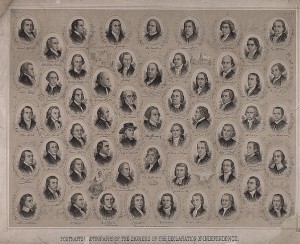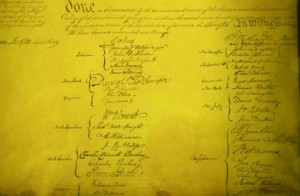 The Constitution has been in the news a lot these days, or shall I say, the violation of the Constitution. Sometimes I wonder if the signers of the Constitution would even be able to recognize the nation that they had envisioned when they wrote the Constitution. I happen to think they would not, but then even at the signing of the Constitution there was controversy. In that way, I suppose there would always be those who would do everything in their power to change or even do away with the Constitution. At the time of the Constitutional Convention in Philadelphia, only 38 of the 41 delegates present at its conclusion, agreed to sign the document. There were those, even then, who disagreed with what was laid out there. I suppose that is common in anything in life. Needless to say, it was a hard-won battle to win the ratification by the necessary nine out of thirteen US states in existence at the time.
The Constitution has been in the news a lot these days, or shall I say, the violation of the Constitution. Sometimes I wonder if the signers of the Constitution would even be able to recognize the nation that they had envisioned when they wrote the Constitution. I happen to think they would not, but then even at the signing of the Constitution there was controversy. In that way, I suppose there would always be those who would do everything in their power to change or even do away with the Constitution. At the time of the Constitutional Convention in Philadelphia, only 38 of the 41 delegates present at its conclusion, agreed to sign the document. There were those, even then, who disagreed with what was laid out there. I suppose that is common in anything in life. Needless to say, it was a hard-won battle to win the ratification by the necessary nine out of thirteen US states in existence at the time.
Before the Constitution, the United States was operating under the Articles of Confederation, which was ratified several months before the British surrender at Yorktown in 1781. The Articles of Confederation and Perpetual Union were an agreement among all thirteen original states in the United States of America. Basically it was the first constitution. Even when not yet ratified, the Articles provided a system for the Continental Congress to direct the American Revolutionary War, conduct diplomacy with Europe, and deal with territorial issues and Native American relations, but it was weak in that it didn’t allow for our president, a court system, or taxation, thereby leaving us with a weaker government. Congress was also given no authority to enforce its requests to the states for troops, giving us a weaker military force. Yet, even with the proposed changes, there were those who would disagreed with the proposed new Constitution.
When the Constitutional Convention was convened on May 25, 1787, the plan had been to amend the Articles  of Confederation, but that plan was quickly set aside in favor of writing a completely new Constitution. The meeting was held in Philadelphia’s Pennsylvania State House. It is now known as Independence Hall. Revolutionary War hero George Washington, a delegate from Virginia was elected as convention president. The debate was heated, but in the end, the delegates came up with a brilliant federal organization that boasted an intricate system of checks and balances. One of the main divisions in the discussions was that the more populated states wanted a state representation in Congress, and the smaller states wanted equal representation. That problem was solved by the Connecticut Compromise, which proposed a two chamber legislature with proportional representation in the lower house known as the House of Representatives and equal representation of the states in the upper house known as the Senate. It seemed a fair way to do it, but there are still those who disagree to this day.
of Confederation, but that plan was quickly set aside in favor of writing a completely new Constitution. The meeting was held in Philadelphia’s Pennsylvania State House. It is now known as Independence Hall. Revolutionary War hero George Washington, a delegate from Virginia was elected as convention president. The debate was heated, but in the end, the delegates came up with a brilliant federal organization that boasted an intricate system of checks and balances. One of the main divisions in the discussions was that the more populated states wanted a state representation in Congress, and the smaller states wanted equal representation. That problem was solved by the Connecticut Compromise, which proposed a two chamber legislature with proportional representation in the lower house known as the House of Representatives and equal representation of the states in the upper house known as the Senate. It seemed a fair way to do it, but there are still those who disagree to this day.
It would seem like they had an instant solution, but that wasn’t so. As dictated by Article VII, the document would not become binding until it was ratified by nine of the 13 states. On December 7, Delaware, Pennsylvania, New Jersey, Georgia, and Connecticut ratified the Constitution in quick succession. Other states, especially Massachusetts, opposed the Constitution, because it failed to reserve undelegated powers to the states and lacked constitutional protection of basic political rights, such as freedom of speech, religion, and the press, which I personally agree with. By February 1788, they had reached a compromise under which Massachusetts and other states would agree to ratify the document and that amendments would immediately be added to provide the protections they proposed. The Constitution was then narrowly ratified in Massachusetts. Maryland and South Carolina quickly followed. On June 21, 1788, New Hampshire became the ninth state to ratify the document, and it was agreed that government under the US Constitution would begin on March 4, 1789. In June, Virginia ratified the Constitution, followed by New York in July. The Constitution was signed on this day, September 17, 1787.
As promised, on September 25, 1789, the first Congress of the United States adopted 12 amendments to the  US Constitution, called the Bill of Rights. The Bill of Rights was then sent to the states for ratification. Ten of these amendments were ratified in 1791. In November 1789, North Carolina became the 12th state to ratify the US Constitution. Rhode Island, which opposed federal control of currency and was critical of compromise on the issue of slavery, resisted ratifying the Constitution until the US government threatened to sever commercial relations with the state. On May 29, 1790, Rhode Island voted by two votes to ratify the document, and the last of the original 13 colonies joined the United States. Today, the US Constitution is the oldest written constitution in operation in the world. That should say something, and it should be reason to protect it.
US Constitution, called the Bill of Rights. The Bill of Rights was then sent to the states for ratification. Ten of these amendments were ratified in 1791. In November 1789, North Carolina became the 12th state to ratify the US Constitution. Rhode Island, which opposed federal control of currency and was critical of compromise on the issue of slavery, resisted ratifying the Constitution until the US government threatened to sever commercial relations with the state. On May 29, 1790, Rhode Island voted by two votes to ratify the document, and the last of the original 13 colonies joined the United States. Today, the US Constitution is the oldest written constitution in operation in the world. That should say something, and it should be reason to protect it.


2 Responses to The Signing Of The United States Constitution